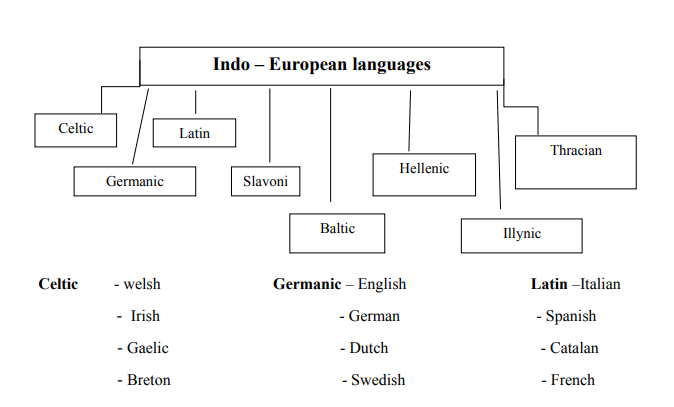To the indo-European language family belong most languages of Europe. The IndoEuropean family is divided into several groups:
The Indo-European language family (Ramat and Ramat 1998) covers most of Europe
and spreads, with some breaks, across Iran and Central Asia down into South Asia. As a
result of colonial expansion, it is now also dominant in the Americas and in Australia and
New Zealand.
In Europe itself, only a few peripheral areas are occupied by non-Indo-European
languages, in particular areas where Basque and some Uralic languages are spoken and parts
of the Caucasus. The Indo-European family subdivides into a number of well established
branches.
The Celtic languages (Ball 1993, MacAulay 1993) were once also dominant
languages of western and central Europe, but with the expansion of Germanic and Romance
languages in particular they have retreated to the western fringes of Europe, the living
languages being Welsh in Wales, Irish on the west coast of Ireland, Breton in Brittany
(France), and Scots Gaelic in northwestern Scotland.
The Romance languages (Harris and Vincent 1988, Posner 1996) occupy most of
southwestern Europe, and are the descendants of Latin, the language of the Roman Empire.
Strictly speaking, the branch of Indo-European is Italic, since it includes a number of
languages other than Latin that died out by the early centuries of the Common Era as a result
of Roman and Latin expansion, so that all living Italic languages are in fact Romance
languages. The major living languages are French, Catalan, Spanish, Portuguese, Italian, and
Romanian.
The Germanic languages (Konig and van der Auwera 1994) are the dominant
languages of northwestern Europe, extending into central Europe. This is the language family
that includes English, and also Dutch, German, and the Scandinavian languages (including
Danish, Norwegian, Swedish, and Icelandic); an offshoot of German with considerable
admixture from Hebrew-Aramaic and Slavic is Yiddish, the traditional language of
Ashkenazi Jews and a widely spoken language of Eastern Europe before the Holocaust. The
Scandinavian languages form North Germanic, while the other languages cited are West
Germanic; a third sub-branch of the family, East Germanic, is now extinct, the only
substantially attested language being Gothic.
Turning to Eastern Europe, the northernmost Indo-European branch is Baltic, now
consisting of the two languages, Lithuanian and Latvian. The Baltic languages have a
particularly close relation to the Slavic (Slavonic) languages (Comrie and Corbett 1993), now
dominant in much of eastern and central Europe and including three subbranches. The East
Slavic languages are Russian, Belarusian (Belorussian), and Ukrainian. The West Slavic
languages include Polish, Czech, and Slovak. The South Slavic languages are Slovenian,
Serbo-Croatian, Bulgarian, and Macedonian. As a result of ethnic differences, what linguists
would, on grounds of mutual intelligibility, consider a single Serbo- Croatian language is
now often divided into Serbian and Croatian, with Bosnian sometimes added as a third ethnic
variety.
Two further branches of Indo-European, each consisting of a single language, are
found in the Balkans. Albanian consists of two dialect groups, Gheg in the north and Tosk in
the south, which might well be considered distinct languages on the basis of the mutual
intelligibility test, although there is a standard language based on Tosk. Hellenic includes
only Greek, although it is customary to give a different name to the branch, in part because it
includes varieties of Greek over more than three millennia, from Mycenean through Classical
Greek and Byzantine Greek to the modern language.
Armenian, spoken primarily in Armenia though also in the Armenian Diaspora
originating in eastern Turkey, is another branch of Indo-European consisting of a single
language, although the differences between Eastern Armenian (spoken mainly in Armenia)
and Western Armenian (spoken originally mainly in Turkey) are considerable, and there are
two written languages.
Finally, with respect to the living languages, the Indo-Iranian languages are spoken
from the Caucasus to Bangladesh. Indo-Iranian divides into two sub-branches, Iranian and
Indo-Aryan (Indic), the latter occupying an almost continuous area covering most of
Pakistan, northern India, Nepal, and Bangladesh. The most widely spoken Iranian languages
are Persian (Iran), with national variants Tajik (in Tajikistan) and Dari (in Afghanistan),
Kurdish (mainly in the border area of Turkey, Iran, and Iraq), Pashto (in Afghanistan and
Pakistan), and Balochi (in Pakistan).
The Indo-Aryan sub-branch of Indo-Iranian (Masica 1991) includes Sanskrit, the
classical language of Indian civilization; Pali, the sacred language of Buddhism; and a large
number of modern languages, of which the most widely spoken are Hindi and Urdu,
essentially different national forms of the same language, in India and Pakistan respectively;
Sindhi and Western Panjabi (Lahnda) in Pakistan; Nepali in Nepal; and Kashmiri, Eastern
Panjabi, Gujarati, Rajasthani, Marathi, Bhojpuri, Maithili, Assamese, and Oriya in India;
Bengali in India and Bangladesh; and Sinhala, geographically separated from the other IndoAryan languages in Sri Lanka. It should also be noted that the various Romani languages,
spoken by Rom (Gypsies), belong to the Indo-Aryan group of languages.
In addition, two branches of Indo-European consist of extinct but well attested
languages. The best known of the Anatolian languages, spoken in what is now Turkey, is
Hittite, language of a major ancient empire (seventeenth-twelfth centuries BCE). Tocharian is
a family of two closely related languages, attested in texts from the latter half of the first
millennium CE in what is now the Xinjiang region in northwestern China


Titany answered the question on
May 11, 2022 at 09:31